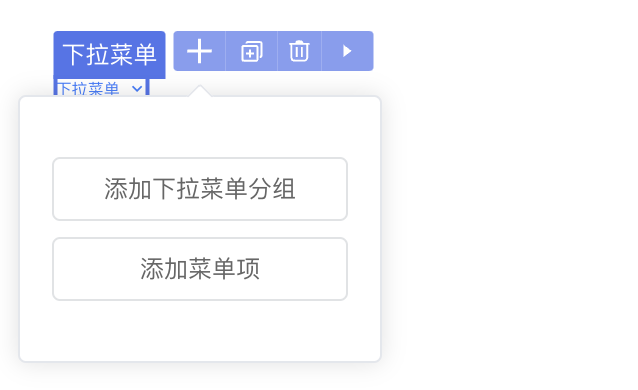插槽处理
1. 功能说明
组件的插槽是一种用于在组件中传递内容的机制,它允许父组件向子组件传递内容,使得子组件可以更加灵活地展示不同的内容。
2. 功能实现
2.1 插槽配置
在 api.ts 文件中使用@Slot来描述组件插槽。插槽属性名以slot开头的小驼峰命名,例如:默认插槽slotDefault;具名插槽例如写为slotHeader。
以下简单描述插槽常见的处理方式:
默认插槽
没有特定的名称标识,它提供了一种简单的方式让父组件向子组件传递内容,并在子组件的特定位置进行渲染。
以 Dropdown 下拉菜单组件为例:

typescript
// 在 @Component 上增加ide 配置
@ExtensionComponent({
// ...
ideusage: {
idetype: 'container',
structured: true, // 设置为 true 才会出现 ”+“ 按钮
}
})
export class ElMenuOptions extends ViewComponentOptions {
// 以Menu 为例
// ...
@Slot({
title: 'Default', // 名称
description: '内容', // 描述
snippets: [ // ide 编辑 “+” 点击后的提示, title提示描述, code 点击后默认添加代码
{
title: '添加下拉菜单分组',
code: '<el-menu-item-group></el-menu-item-group>',
},
{ title: '菜单项', code: '<el-menu-item></el-menu-item>' },
],
})
slotDefault: () => Array<nasl.ui.ViewComponent>;
}具名插槽
允许父组件在使用子组件时,可以将不同的内容插入到子组件的特定插槽位置,并且通过名称来区分不同的插槽。
typescript
export class XxxOptions extends ViewComponentOptions {
// ...
@Slot({
title: '头部内容',
description: '头部内容',
})
slotHeader: () => Array<nasl.ui.ViewComponent>;
}作用域插槽
允许子组件向父组件传递数据,以便父组件可以根据这些数据来渲染插槽内容。
typescript
export class XxxOptions extends ViewComponentOptions {
// ...
@Slot({
title: '循环项的插槽',
description: '自定义选项的结构和样式',
})
slotItem: (current: Current<T>) => Array<nasl.ui.ViewComponent>;
}
// current 参数类型
declare namespace nasl.ui {
export class Current<T> {
item: T;
index: nasl.core.Integer;
rowIndex: nasl.core.Integer;
columnIndex: nasl.core.Integer;
value: nasl.core.String;
}
}- Current 为平台默认插槽参数类型,也支持自定义类型。
typescript
slotItem: (current: {
row: T,
disabled: nasl.core.Boolean,
// ....
})2.2 页面编辑器适配
在 api.ts 文件中配置 ideusage 将组件接入设计器。
typescript
// 在 @Component 上增加ide 配置
@ExtensionComponent({
// ...
ideusage: {
idetype: 'container',
}
})- idetype为 container的组件可以插入子节点。
更多配置项可查看文档页面编辑器适配说明-container配置。
